Pallet Inverter: How to Reduce Handling Time in Shipping Terminals?
Are your shipping terminal operations a constant source of frustration? I see it all the time. Manual handling processes create bottlenecks, leading to delays that ripple through the entire supply chain. Your team is busy restacking goods from one pallet to another. This work is slow, it’s physically demanding, and it’s expensive. Every minute your team spends on this task is a minute not spent on moving finished products out the door. This inefficiency directly eats into your profits, a problem that gets worse as labor and energy costs continue to rise. What if you could change a full pallet of goods in under 60 seconds, using just one operator? The solution is simpler than you think. A pallet inverter is a powerful tool designed to solve this exact problem, transforming your handling process and cutting down time significantly.
A pallet inverter reduces handling time in shipping terminals by automating the entire process of transferring goods between pallets. Instead of manual restacking, the machine securely clamps the load, rotates it 180 degrees, and allows the original pallet to be removed from the top. After placing a new pallet, the machine rotates back. This entire cycle can be completed in about one minute, which dramatically increases throughput, minimizes labor costs, and prevents product damage often associated with manual handling.
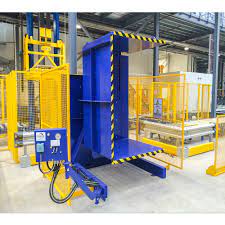
I understand that as a business owner, you need to see a clear return on any investment. You need to know how a piece of equipment will solve your specific, real-world problems. It's not just about speed; it's about cost, reliability, and how it fits into your long-term strategy for growth and modernization. So, let’s move beyond the basic concept. Let's explore how a pallet inverter can be a strategic asset, especially in a demanding environment like a steel mill, and address the core challenges you face every day.
How can a pallet inverter directly address rising operational costs?
You are constantly watching your operational budget. Unpredictable energy prices and steadily increasing labor costs put constant pressure on your margins. You look for savings everywhere. Manual pallet handling might seem like a small part of your overall operation, but its costs are hidden and they add up fast. You are paying for the time it takes multiple workers to handle a single pallet. You are paying for products that get damaged during the clumsy process of restacking. And you carry the risk and cost of potential workplace injuries.
These are not small expenses. They are direct hits to your bottom line. Every damaged coil or broken strap is a loss. Every hour of labor spent on restacking is an hour that could have been used for more productive, value-adding tasks. A pallet inverter is a direct solution to these problems. It is a focused tool that attacks these specific costs. It turns a task that takes multiple people several minutes into a streamlined process that takes one person about a minute. This change delivers immediate and measurable savings in labor, product waste, and safety-related expenses.
A pallet inverter directly addresses rising operational costs by fundamentally changing how you use labor and protect your products. It replaces a slow, multi-worker manual task with a fast, one-operator automated process. This leads to immediate savings on wages. It also secures the load during transfer, which minimizes costly damage to finished goods. Modern inverters are also designed for energy efficiency, consuming less power than running multiple forklifts for a longer period to accomplish the same task.
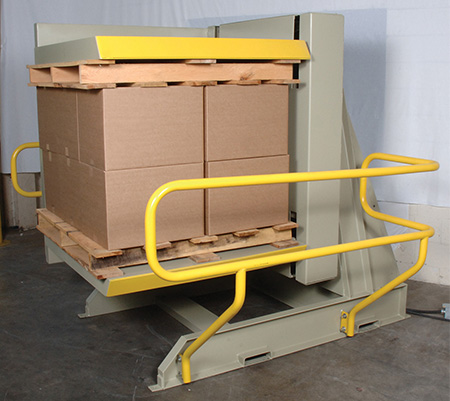
Deeper Dive: A Breakdown of Cost Savings
Let's get specific about how a pallet inverter impacts your budget. As someone who has managed a factory floor and a company's finances, I always focus on tangible numbers. The ROI for a pallet inverter is not just a vague promise; it can be calculated.
1. Labor Cost Reduction
Manual pallet exchange is a time-consuming task. A typical scenario might involve two or three workers and take 10-15 minutes per pallet. A pallet inverter reduces this to one operator and about one minute.
Let's look at a simple comparison:
| Metric | Manual Handling | With Pallet Inverter |
|---|---|---|
| Workers Required | 2-3 | 1 |
| Time per Pallet | 15 minutes | 1 minute |
| Total Labor Minutes | 30-45 minutes | 1 minute |
| Pallets per Hour | 1-2 | up to 50 |
The math is clear. You are not just saving on the hourly wages of one or two employees. You are reallocating their valuable time to other critical tasks, like loading trucks or preparing the next shipment. This improves overall plant productivity without increasing your headcount.
2. Product Damage Mitigation
In a steel mill, products are heavy and can be easily damaged. A dented steel coil or a scratched bundle of wire can lead to customer rejection or require costly rework. Manual handling, with its reliance on prying bars and individual lifting, is a major cause of this damage. A pallet inverter clamps the entire load with controlled, even pressure. The load is held securely as a single unit throughout the entire 180-degree rotation. This gentle but firm handling preserves the integrity and finish of your products. Reducing damage by even a small percentage can lead to tens of thousands of dollars in savings annually.
3. Reducing Indirect and Safety Costs
Workplace injuries are expensive. They lead to lost workdays, increased insurance premiums, and potential legal costs. Manually handling heavy, awkward loads is a high-risk activity that leads to back strains and other musculoskeletal injuries. By automating this task, you significantly reduce the physical strain on your employees, creating a safer work environment and lowering your exposure to these costs.
What are the key differences between a standard pallet inverter and one designed for a high-throughput steel mill?
You have likely seen pallet inverters before, perhaps in a food processing plant or a pharmaceutical warehouse. They handle neat stacks of boxes on standard pallets. It is easy to look at those machines and think they are not built for your world. In a steel mill, the environment is harsh. The loads are heavy, often oddly shaped, and abrasive. The operational pace is relentless, running 24/7.
Putting a standard, light-duty machine into that environment would be a costly mistake. It would break down. A failure on a key piece of handling equipment creates a bottleneck that can bring your entire shipping operation to a halt. Downtime is the single biggest enemy of profitability in a high-capacity plant. When you are looking to upgrade an aging production line, choosing equipment that is not robust enough for the job is not an option. It's a recipe for failure. You need more than a standard machine; you need an engineered solution built specifically for the extreme demands of the steel industry.
The primary difference between a standard pallet inverter and a machine for a steel mill lies in its heavy-duty construction, load capacity, and clamping technology. A steel mill-grade inverter is built with a reinforced, heavy-gauge steel frame and powerful hydraulics to handle loads exceeding 2000 kg. Its clamping system is also more advanced, often featuring adjustable pressure and specialized surfaces to securely handle heavy and irregular loads like steel coils or bundles of wire without causing damage, ensuring durability and reliability in a harsh, continuous-use environment.
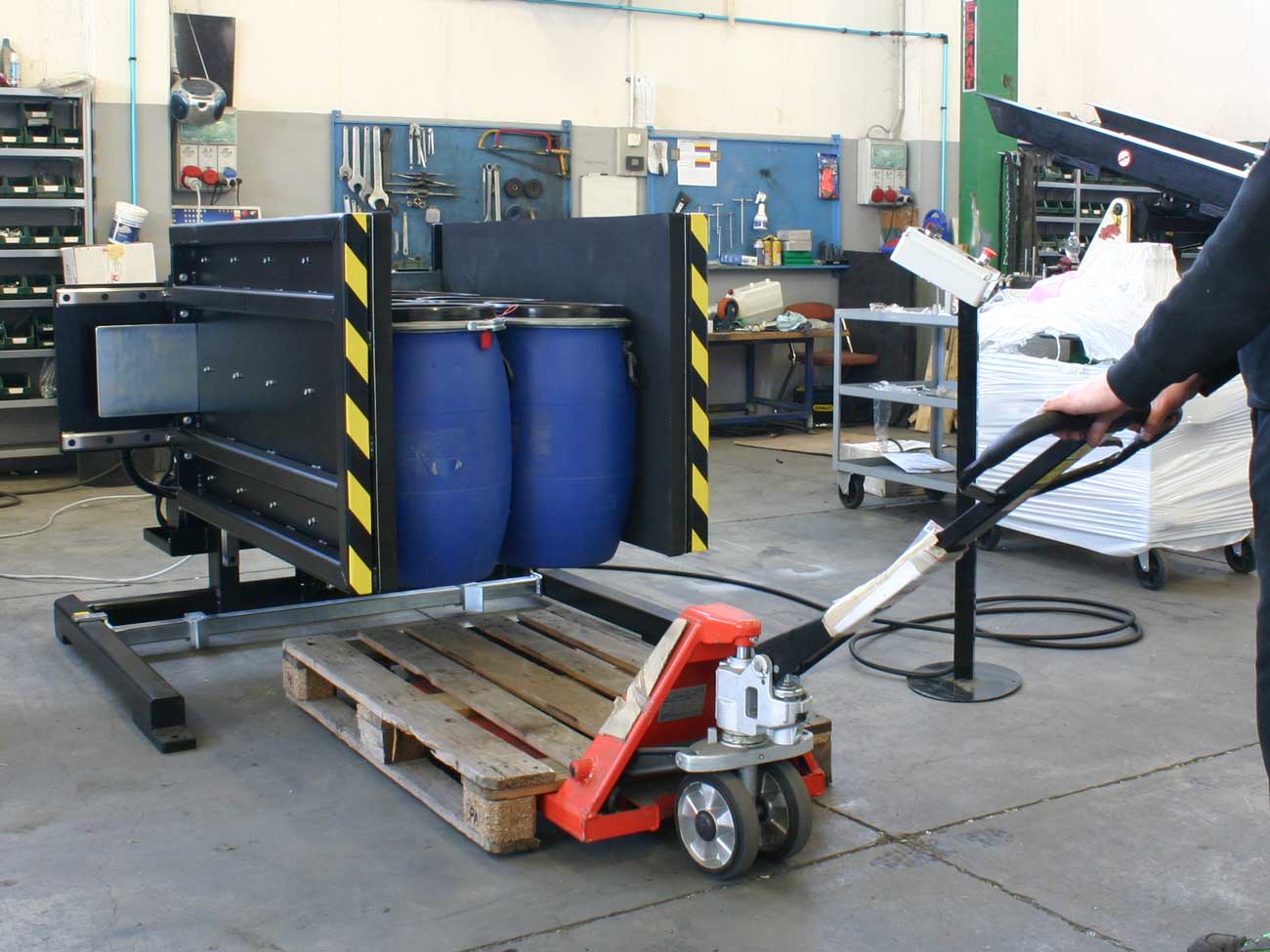
Deeper Dive: Engineering for the Steel Environment
A machine that succeeds in a steel mill is not just a scaled-up version of a standard model. It is fundamentally different in its design philosophy and construction. I learned this firsthand when building machines for heavy industry. The details matter.
1. Structural Integrity and Materials
The foundation of a heavy-duty inverter is its frame. Standard machines might use thinner steel or bolted connections. A machine for your plant must be built with a continuously welded, heavy-gauge steel frame. All components, from the hydraulic cylinders to the electric motors and bearings, must be oversized for the application. This isn't about over-engineering; it's about engineering for survival. The machine must withstand not only the weight of the load but also the incidental contact from forklifts and the general wear and tear of a demanding industrial setting.
2. Advanced Clamping for Unique Loads
A box of consumer goods is a stable, uniform load. A steel coil or a pallet of steel wire is not. These loads are dense, have a high center of gravity, and can shift. A simple flat clamping plate is not sufficient.
| Feature | Standard Inverter | Steel Mill Inverter |
|---|---|---|
| Clamping Surface | Flat steel plate | Ribbed or rubber-lined plate |
| Pressure Control | Basic on/off or manual set | PLC-controlled, adjustable pressure |
| Load Handling | Uniform, stable loads | Heavy, concentrated, irregular loads |
| Typical Capacity | 1000-1500 kg | 2000-5000+ kg |
A heavy-duty inverter uses a more sophisticated clamping system. The pressure is precisely controlled by a PLC, allowing the operator to set the right force for different products. This prevents crushing a lighter load or failing to secure a heavier one. The clamping surfaces are often lined with durable rubber or have a ribbed profile to provide extra grip on smooth or uneven surfaces.
3. Duty Cycle and Reliability
"Duty cycle" refers to how much a machine can be used in a given period without overheating or wearing out. Many standard inverters are designed for an intermittent duty cycle, maybe 10-20 cycles per hour. In a shipping terminal aiming for high throughput, you need a machine designed for a continuous duty cycle. This means it can run constantly, 24 hours a day, 7 days a week, with only planned stops for maintenance. This level of reliability comes from using higher quality components, better cooling systems for the hydraulics and motors, and a design that simplifies inspection and service.
How does a pallet inverter contribute to digitalization and data-driven decisions?
You have a forward-thinking goal to create a "smart factory." You want to connect your equipment, collect data, and use that information to make smarter, faster decisions. It is easy to see how a complex CNC machine or a robotic welding cell fits into this vision. But what about a seemingly simple piece of handling equipment like a pallet inverter? It can feel disconnected from your high-level MES and IoT strategy.
This is a common blind spot. If you treat any piece of equipment as a standalone "island," you create gaps in your data. You cannot see the complete picture of your production flow. You can't accurately trace bottlenecks back to their source. And your goals for a fully connected, digital operation remain incomplete. The reality is that a modern pallet inverter is not a simple, dumb machine. It is a critical data point in your logistics chain. When equipped with the right technology, it becomes an active node in your smart factory ecosystem, feeding you valuable information about your handling efficiency.
A pallet inverter contributes to digitalization by serving as an intelligent data collection point within your logistics workflow. Modern inverters are equipped with PLC controls and can be fitted with IoT sensors that integrate directly with your Manufacturing Execution System (MES) or SCADA system. They can track and report key data points like cycle counts, operating hours, average load weight, and fault diagnostics. This real-time data is essential for monitoring performance, enabling predictive maintenance, and achieving the comprehensive production visibility you need for a truly data-driven operation.
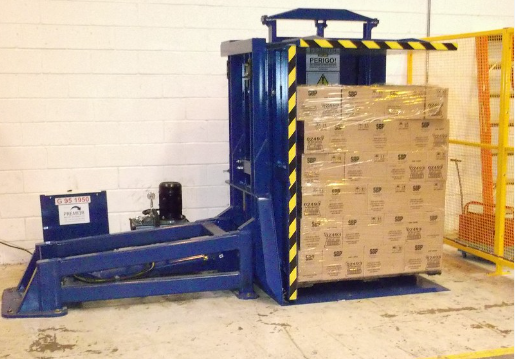
Deeper Dive: From Mechanical Action to Actionable Data
Let's break down how this integration works and the value it creates. The goal is to turn the physical action of inverting a pallet into digital information that helps you meet your larger business objectives, like improving uptime to 95% and reducing costs.
1. Integration with Your MES/SCADA Systems
A modern pallet inverter's brain is its Programmable Logic Controller (PLC). This PLC can communicate with your plant's central control systems using standard industrial protocols like PROFINET, EtherNet/IP, or Modbus TCP. This connection is the bridge between the machine and your digital platform. Once connected, the inverter can automatically send a stream of valuable data.
| Data Point from Pallet Inverter | Potential Business Insight (for you, Javier) |
|---|---|
| Cycle Count per Shift/Day | Measure throughput and identify your most productive shifts. |
| Average Cycle Time | Pinpoint slowdowns or operator training needs. |
| Load Weight (with optional scales) | Verify shipment weights automatically and collect production data. |
| Machine Status (Running, Idle, Fault) | Get real-time visibility into equipment utilization and downtime. |
| Fault Codes | Instantly notify maintenance of the exact problem (e.g., "Hydraulic pressure low"). |
This data provides a clear, objective view of what is happening in your shipping area, replacing guesswork with hard facts.
2. Enabling Predictive Maintenance
One of your biggest challenges is aging equipment and rising failure rates. Predictive maintenance is the solution. Instead of reacting to breakdowns, you predict them. A smart pallet inverter is a key part of this strategy. It can be equipped with sensors that monitor its health:
- Vibration sensors on the motor can detect bearing wear before it leads to failure.
- Temperature sensors on the hydraulic power unit can signal overheating issues.
- Pressure sensors in the hydraulic lines can identify leaks or pump inefficiencies.
This sensor data is fed into your analytics platform. The system can learn the machine's normal operating baseline and send an alert when readings deviate from the norm. Your maintenance team gets a notification like, "Motor vibration has increased by 15%. Schedule inspection." This allows you to plan repairs during scheduled downtime, which is critical to achieving your goal of 95% equipment uptime.
What's My Take as an Engineer and Business Owner?
Looking at technical specifications and calculating ROI is absolutely essential. I have spent countless hours doing just that. As an engineer, I love the data. As a business owner, I live by the numbers. But my experience, both on the factory floor and in the owner's office, has taught me a critical lesson: the machine itself is only part of the solution. The most important factor, the one that truly determines long-term success, is not always on the spec sheet. It is the quality of the people you choose to partner with.
The fear of choosing the wrong supplier is real. We have all been tempted by a lower price tag. But what happens when that supplier just delivers a machine and disappears? When that critical piece of equipment goes down in the middle of your busiest season, who do you call? How long will you wait for a technical expert who understands your specific problem? How long will your production line sit idle waiting for a spare part? I faced these exact fears when I was investing my own money to build my factory. It taught me to look beyond the price and evaluate the partnership.
As an engineer and business owner, my take is that the equipment you buy is only 50% of the investment. The other 50% is the strategic partnership you form with the supplier. You need a partner who offers expert consultation before the sale, custom engineering for your specific needs, hands-on installation and training support, and fast, reliable after-sales service. This relationship is your insurance policy. It is what guarantees your machine will deliver its promised value and achieve a strong, long-term return on investment.
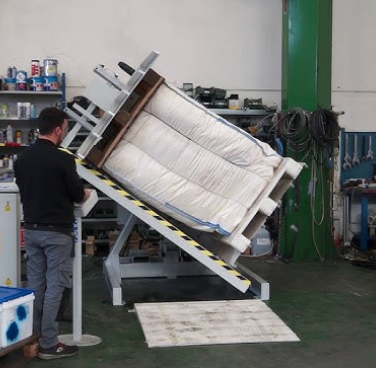
Deeper Dive: The Partnership is the Real Investment
When you, Javier, make a capital investment, you are not just buying steel and hydraulics. You are buying a capability. You are buying uptime, efficiency, and peace of mind. The supplier's role is to ensure you get what you paid for, long after the invoice is settled.
My Journey and Your Challenge
I started my career as an engineer on the factory floor. I saw firsthand what happens when a machine is designed in an office with no understanding of the real-world environment it will operate in. I dealt with equipment that was difficult to service and prone to breaking down at the worst possible moments. Later, as I established my own factory, I felt the immense pressure of every investment decision. I knew that the "cheapest" option was almost never the most profitable one in the long run. My journey from employee to owner taught me to value reliability and support above all else. I see your challenges—rising costs, aging equipment, pressure to digitalize—and I recognize them because I have lived them.
The Power of a True Partnership
A true partner does more than just sell you a standard product. They engage with you to solve your problem. Here is what that partnership should look like:
| Partnership Element | What it Means for You |
|---|---|
| Initial Consultation | They don't just ask "what machine do you want?" They ask "what problem are you trying to solve?" They visit your site, watch your workflow, and understand your unique products and challenges. |
| Custom Engineering | They adapt the machine to your needs. Maybe you need a specific loading configuration (ramp vs. forklift), a special clamping mechanism for your coils, or integration with your specific MES software. One size does not fit all. |
| Installation & Training | They don't just drop a crate at your door. Their technicians are on-site to ensure the machine is installed correctly, safely, and that your operators and maintenance team are fully trained on how to use and care for it. |
| After-Sales Support | This is the most critical part. You need a direct line to technical experts. You need a guarantee of readily available spare parts. You need a partner who is as invested in your uptime as you are. |
I feel a great sense of gratitude for the opportunities this industry has given me. It allowed me to build a business and achieve financial independence. Now, my mission with SHJLPACK is to give back, to share the knowledge I gained through years of trial and error. I want to help other leaders like you make the right decisions, avoid costly mistakes, and build stronger, more profitable operations. Choosing the right partner is the most important decision you will make.
Conclusion
A pallet inverter is more than a machine. It's a strategic tool to cut costs, boost efficiency, and advance your digitalization goals, ensuring your terminal operates at peak performance.




